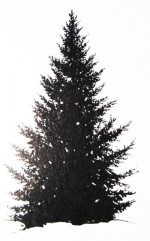 I am always amazed when the head gardener can identify a tree as we speed down the highway. He only needs to catch sight of the silhouettes and he can give the common as well as the botanical name. He claims that it is easier to identify a tree at a distance when he can’t see the bark, cones, and needles in detail and has only the shape of the tree to rely on. Trees tend to grow in a certain manner and assume a characteristic shape. Of course, trees will vary too, depending on the light, moisture, and density of vegetation. A tree grown in an open field will look different than one grown in a forest where it has to compete for light and water. The appearance of a tree will also vary with age; a sapling looks quite different from a mature tree. Still, even with these caveats, identification of trees by their silhouette can be fun and it’s not all that difficult to learn.
I am always amazed when the head gardener can identify a tree as we speed down the highway. He only needs to catch sight of the silhouettes and he can give the common as well as the botanical name. He claims that it is easier to identify a tree at a distance when he can’t see the bark, cones, and needles in detail and has only the shape of the tree to rely on. Trees tend to grow in a certain manner and assume a characteristic shape. Of course, trees will vary too, depending on the light, moisture, and density of vegetation. A tree grown in an open field will look different than one grown in a forest where it has to compete for light and water. The appearance of a tree will also vary with age; a sapling looks quite different from a mature tree. Still, even with these caveats, identification of trees by their silhouette can be fun and it’s not all that difficult to learn.
Let’s start out with five common conifers. I have chosen White pine, Norway spruce, Eastern hemlock, Balsam fir, and Arborvitae (also called northern white cedar).
See if you can ID each and if you can’t just notice the characteristics of each tree. The answers and tips for identification appear below.
A.
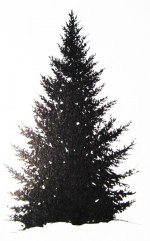
B.
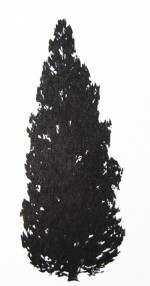
C.
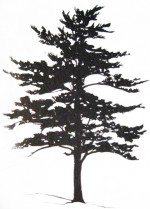
D.
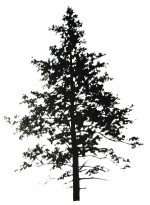
E.
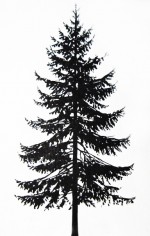
Here are the answers plus comments on key characteristics important to identification.
A. Balsam fir (Abies balsamea). Dense pyramid with upward reaching branches; branch tips extend from the pyramid; the typical Christmast tree; medium texture.
B. Arborvitae (Northern white cedar, Thuja occidentalis). Medium sized, dense, cone–shaped with no individual branches evident.
C. White pine (Pinus strobes). Branches few in number, spreading with horizontal limbs; foliage fine and giving an airy look.
D. Eastern hemlock (Tsuga canadensis). Round top; flexible branches; delicate foliage.
E. Norway spruce (Picea abies). Open branching; branches and needles hang down; course texture.
Now try it again; refer to the above information if you need to. Answers are below.
A.
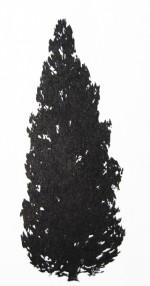
B.
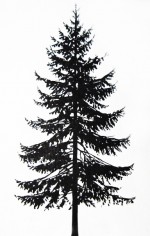
C.
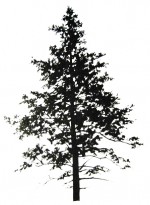
D.
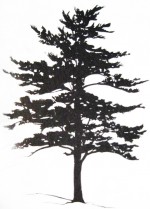
E.
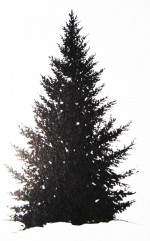
Answers: A. Arborvitae B. Norway spruce C. Eastern hemlock D. White pine E. Balsam fir
When you are outside looking at tree silhouettes go up closer and confirm your ID with a little more information;
Pines: Needles in clusters of 2-5; produce cones.
Spruces: Needles not in clusters and are square in cross section; produce cones.
Firs: Needles not in clusters and are flat; they can not be easily rolled between the fingers; produce cones.
Hemlocks: Needles not in clusters and flat; cones very small (less than 1”)
Arbrovitae: Scales rather than needles on twigs that form flattened sprays that line up vertically; cones bell shaped, ½” long.
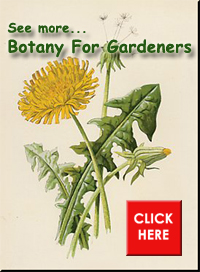 Not every tree follows the rules and there are many more pines, spruces, and firs, plus other kinds of conifers that you might come upon. But the more you look at tree silhouettes, the more you will notice differences and similarities and be able to identify them or at least appreciate them in a new way.
Not every tree follows the rules and there are many more pines, spruces, and firs, plus other kinds of conifers that you might come upon. But the more you look at tree silhouettes, the more you will notice differences and similarities and be able to identify them or at least appreciate them in a new way.
[…] Identification of Some Common Conifers by Silhouettes […]